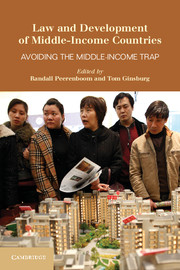Book contents
- Frontmatter
- Contents
- List of Contributors
- Acknowledgments
- 1 Law and Development in Middle-Income Countries
- Part I The Politics of Development in Middle-Income Countries
- Part II Middle-Income Countries in a Globalized Economy
- Part III Good Governance and the Rule of Law in Middle-Income Countries
- 7 Law and Development in Central and Eastern Europe
- 8 Judicial Intervention in Civic-Military Relations
- 9 The Prospects for Anticorruption Law in Middle-Income Countries
- 10 The Delivery of Justice in Middle-Income Countries
- Part IV Socioeconomic Challenges in Middle-Income Countries
- Part V International Donor Strategies for Middle-Income Countries
- Appendix Selected Country Data as of 2011
- Index
- References
10 - The Delivery of Justice in Middle-Income Countries
Published online by Cambridge University Press: 05 June 2014
- Frontmatter
- Contents
- List of Contributors
- Acknowledgments
- 1 Law and Development in Middle-Income Countries
- Part I The Politics of Development in Middle-Income Countries
- Part II Middle-Income Countries in a Globalized Economy
- Part III Good Governance and the Rule of Law in Middle-Income Countries
- 7 Law and Development in Central and Eastern Europe
- 8 Judicial Intervention in Civic-Military Relations
- 9 The Prospects for Anticorruption Law in Middle-Income Countries
- 10 The Delivery of Justice in Middle-Income Countries
- Part IV Socioeconomic Challenges in Middle-Income Countries
- Part V International Donor Strategies for Middle-Income Countries
- Appendix Selected Country Data as of 2011
- Index
- References
Summary
INTRODUCTION
In a recent survey conducted among female victims of violence in Pakistan, formal courts were described by the users as “frightening.” Respondents were also asked to list what they would change about the formal court process for women. Their response was an “overwhelming demand for less delays and quicker disposal of cases.” Formal courts in developing countries – civil law and common-law countries alike – are perceived to be not only bureaucratic and ineffective, but also inaccessible and threatening. There seems to be a global crisis of justice delivery, and it is particularly serious in low- and middle-income countries (MICs). The poor and other marginalized segments of society face significant limitations to access formal judicial institutions in developing countries. Cultural and language barriers, overly complex procedures and cumbersome legal requirements, financial limitations, mistrust for institutions derived from a colonial past, and radically different views on the nature and role of justice in society, among other factors, hamper the ability of low-income citizens to effectively resolve their disputes in official courts.
In old ages, people used customary justice systems to resolve their disputes, ranging from the Cheyenne “conference of tribal chiefs,” to the Afghan Jirgas, to the Liberian chiefdoms, to the Amazonian shamans. While many of these systems continue to operate today, the European colonization process of the past few centuries brought with it a new dispute-resolution system to all corners of the planet. In some places the old forms were completely abandoned while in others a dual arrangement emerged. Parallel systems of dispute resolution coexisted and interacted in most countries. In some places customary justice was formally and hierarchically integrated into the formal (European) judicial machinery, while in others they remained in operation de facto, mostly ignored or tolerated by the formal courts. For decades (in Africa and parts of Asia) or centuries (in Latin America and other parts of Asia), the formal courts were perceived mostly as instruments for resolving disputes among the descendants of European colonizers, the global and local business community, and the local elites. By design, in most colonies and pseudocolonies around the world formal courts were not intended to be widely accessible to ordinary folk. However, this was not seen as a problem per se, because people still had access to their customary justice systems.
- Type
- Chapter
- Information
- Law and Development of Middle-Income CountriesAvoiding the Middle-Income Trap, pp. 195 - 218Publisher: Cambridge University PressPrint publication year: 2014
References
- 1
- Cited by

